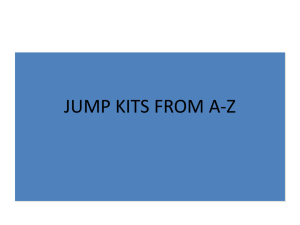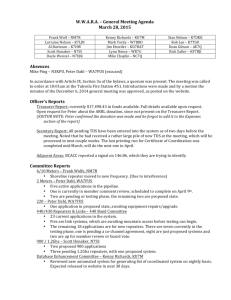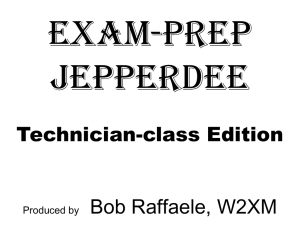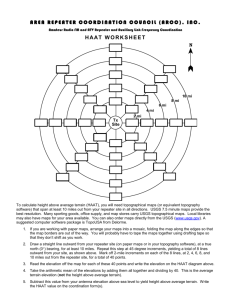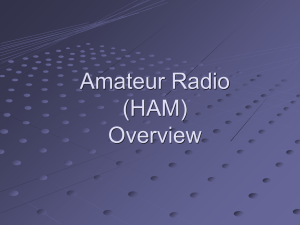Repeater Usage Rules and Guidelines K5QHD 146.66-/442.70+
advertisement
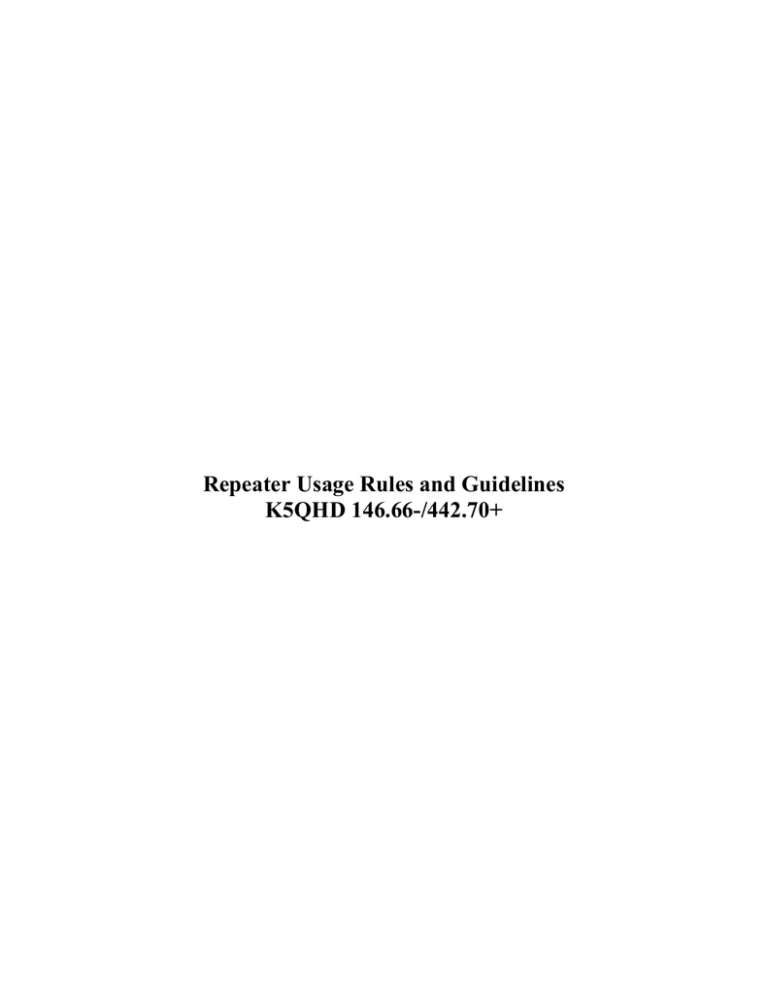
Repeater Usage Rules and Guidelines K5QHD 146.66-/442.70+ Index Page Section Title 2 Index 3 Preface 4 1 Introduction 5 2 Autopatch Usage 6 3 Entering a QSO 6 4 Initiating a Call 7 5 Net Conditions 8 6 Emergency Procedures 9 7 Accessing the Repeater’s Testing Features 10 8 Repeater Maintenance 1. Introduction Welcome to the K5QHD repeaters. The 146.66- and 442.70+ MHz repeaters are located at the Baylor Hospital in Garland. They are open repeaters with a closed patch, available 24 hours per day. During emergency conditions, the repeaters are used only for emergency traffic through a net control station. Occasionally, the repeaters are used for other nets or special events. Even though the Garland Amateur Radio Club repeaters are open repeaters, the features of the repeaters are reserved for the club members only. Board members or officially appointed members should be the only personnel to give out the autopatch and other special feature codes. Of course all usage of the repeater will fall within the guidelines of the FCC rules and regulations, but some of the following rules are for common courtesy and common procedures. Following these rules will help make the repeater enjoyable for everyone. Remember that we all want to have fun and enjoy the repeaters so please be courteous and respectful to others. NOTE: All FCC rules will be followed on the repeaters at all times!!! Failure to follow FCC rules will result in the repeater being turn off or in some way disabled with or without warning. 2. Autopatch Usage The Garland Amateur Radio Club repeaters are QSO or conversation priority repeaters. This means that if there is a QSO is progress then it up to the parties involved in the QSO whether to relinquish the frequency for an autopatch, except in an emergency. The autopatch is available on both repeaters, so if you have a dual band radio and there is a QSO in progress on one repeater it would be best to use the other repeater for patches. The following procedure for autopatches is to be used on the GARC repeaters. Procedure 1. ID and ask if the repeater is in use, unless you have been monitoring for about ten minutes. 2. Use some form of the following sentences: "(your callsign) to the Autopatch", "(your callsign) to the K5QHD Autopatch", or "(your callsign) to the Patch" 3. Dial up the code and the phone or speed dial number you wish. 4. When complete, dial in the autopatch down code and wait for the repeater to shut the call down. 5. Use some form of the following sentences to clear from the autopatch: "(your callsign) clear the patch", "(your callsign) clear the K5QHD patch", or "(your callsign) clear the autopatch" NOTE: All FCC rules apply for autopatches as well!!! Please tell the person you calling that you are on the radio. It is a good idea to talk to persons, whom you may call over the autopatch, to explain to them some of the rules that apply to amateur radio. Also, explain that you both can not talk at the same time, this is a half-duplex connection. 3. Entering a QSO The Garland Amateur Radio Club repeaters use a courtesy tone to indicate the end of a transmission. The normal courtesy tone sequence is 1-second delay after the receiver activity ends, then the courtesy tone, and then a 2-second hang time. If you use the delay between the end of a transmission and the courtesy tone to enter the QSO you will be able to enter without doubling with anyone. Also, during the QSO you should wait for the courtesy tone before transmitting, the courtesy tone resets the timeout timer. When there is a QSO in progress and you wish to enter that QSO, please follow one of the procedures below. If you have an emergency please use the emergency procedure for breaking in. Please note that it is common courtesy to give your callsign when entering an in progress QSO. Procedure 1 1. Wait for a break. 2. Keyup and say your callsign. 3. Unkey and wait to be recognized. Please keep in mind this may take a minute if the previous parties want to finish their train of thought. Procedure 2 1. Wait for a break. 2. Keyup and give your callsign and a short comment. 3. Unkey and wait to be recognized. Please keep in mind this may take a minute if the previous parties want to finish their train of thought. Procedure 3 1. Wait for a break. 2. Give a quick comment and then your callsign. 3. Unkey and wait to be recognized. Please keep in mind this may take a minute if the previous parties want to finish their train of thought. 4. Initiating a Call Before initiating a call on the Repeater, listen for 1 to 2 minutes to the frequency to insure it is not in use. Frequently there are pauses in QSO’s which may last from seconds to minutes depending on the nature of the pause. If after listening for a few minutes you hear no traffic, key up and ask if the frequency is in use. Only after you have insured the repeater is idle, should you make your call to another station. 5. Net Conditions Please take a note of what the normal courtesy tone sounds like, it is three tones during normal conditions. If there is a RACES net on either repeater then it will be one short beep. If there is a dual beep or two tones of any kind then this is some other type of net. Please listen prior to transmitting to find out what type of net it is. The GARC has various nets that occur both on a regular basis and intermittently. If you hear a net in progress, please standby and let the net business be handled. If this is an open net please feel free to join in, but listen first. If you have an emergency and need to use the repeater during any of these nets please use the emergency procedure for breaking in described in Section 5 of these Guidelines. The net conditions are identified by the following courtesy Tones: 1. RACES: one beep and very short squelch tails. 2. Misc. Net: Two beeps similar to the RACES single beep. 3. Monday night net: Two beeps lower in frequency than the RACES beeps. 6. Emergency Procedure Use this procedure during any emergency situation, which threatens life or property. This procedure can be used to break into any QSO, Net, or activity on the repeater. 1. Wait for a pause in the repeater activity. 2. Keyup and say "BREAK, BREAK (and your callsign)" Please note that if someone says this all other traffic stops! 3. Unkey and then either allow a net control or someone on frequency to recognize you. 4. Give net control or the person who is helping you all necessary information. If no one on frequency can help and you want to use the patch then please follow the emergency patch procedure below. Emergency Autopatch 1. Follow standard patch rules to bring up the patch. 2. Wait for emergency personnel to answer. 3. Identify yourself as an Amateur Radio Operator and give your name and callsign. 4. Follow standard rules to shutdown the patch. Be prepared to explain how you are making the call. A simple explanation is that you are dialing through a radio system. Most emergency personnel do understand calls over radios. 7. Accessing the Repeater’s Testing Features This procedure should be used anytime that you wish to access the repeater's various testing features, such as the time, date, and test announcements. 1. Make sure the frequency is not in use. 2. Use some type of identifying statement; for example "(your callsign) to the K5QHD repeater.", "(your callsign) TESTING", or "(your callsign) testing with the K5QHD repeater. Please note that if you do not identify yourself before each test or feature call the control operators may consider you a hacker. In this case the repeater could be shut off in the middle of your test. Please identify yourself. 3. Key up and proceed with your test or feature call. 4. When complete please clear with your callsign. 8. Repeater Maintenance Please be aware that if someone is working on the repeater, it may go down at anytime. Following the points listed below would be greatly appreciated. 1. Please listen to the person doing maintenance for any special instructions. 2. Please leave longer than normal pauses between transmissions to allow for further information to be passed at anytime. 3. Do not try and access the autopatch or other features unless you contact the person doing the maintenance. 4. Please keep in mind that it is usually very warm or cold in the repeater room and the personnel working on the repeater would like to complete the work as quickly as possible. It is always our intention to keep maintenance to a minimum, but as everyone knows this equipment requires some up keep. We want the repeater to be there when we really need it. Thank you for your patience in this area.
